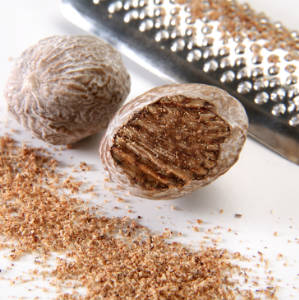All Ingredients
nopales
The canned version is acceptable substitute for fresh, but it has an inferior texture.
Learn morenova
Nova is made by curing salmon through both curing with salt and smoking. It is similar to lox.
Learn morenut butter
If you mix roasted nuts, vegetable oil, salt, and maybe some sugar in a blender or food processor for awhile, you'll get a smooth, spreadable paste called nut butter. Nut butters can be spread on bread or crackers, blended into savory sauces, or teamed up with chocolate to make desserts.
Learn morenut flour
Nut flours are ground from the cake that remains after oils are pressed from nuts. They're great for breading fish or chicken, and they add a rich flavor to baked goods. Nut flour lacks the gluten that baked goods need to rise, so in those recipes substitute no more than 1/4 of the wheat flour with nut flour. Nut flours go stale quickly, so store them in the refrigerator or freezer, and use them up quickly.
Learn morenut meal
Nut meals are ground from whole nuts, and are grittier and oilier than nut flours, which are ground from the cake that remains after the oils are pressed from nuts. To make your own nut meals, grind toasted nuts in a nut mill until the meal has the consistency of cornmeal. You can also use a food processor fitted with a steel blade to do this, but it's hard to keep the nut meal from turning into nut butter. It helps to freeze the nuts before grinding, to use the pulse setting on the processor, and to add any sugar in the recipe to the nuts to help absorb the oils. Store nut meals in the refrigerator or freezer, and use them soon after you buy or make them.
Learn morenutmeg
Freshly grated whole nutmeg tastes far better than packaged ground nutmeg, and has a much longer shelf life.
Learn morenutritional yeast
This nutritional supplement has a pleasant nutty-cheesy flavor and is packed with protein and B vitamins. It comes in flakes or powder and is popular with vegans and health buffs who use it to make cheese substitutes, gravies, and many other dishes. It's also a great topping for popcorn. Nutritional yeast is very similar to brewer's yeast, which is also used as a nutritional supplement and is made from the same strain of yeast. The difference is that brewer's yeast is a by-product of beer production and retains some of the bitter flavor of hops. Don't confuse nutritional yeast, which is deactivated, with active forms of yeast, like the kinds bakers, brewers, and winemakers use. If you eat them, active yeasts will continue to grow in your intestine, robbing your body of valuable nutrients. Look for nutritional yeast at health food stores. Get fortified nutritional yeast if you're taking it as a source of vitamin B12.
Learn morenuts
Cooks and grocers define nuts as anything with edible kernels and hard shells. This includes true nuts like chestnuts and acorns, but also things that botanists would class as seeds, like Brazil nuts, or legumes, like peanuts. Nuts are usually high in fat and protein, and people throughout the world eat them as snacks or incorporate them into both sweet and savory dishes. Many nuts can be eaten raw but roasting them helps intensify their flavor. Nuts are usually harvested in the fall, and it's best to buy unprocessed nuts then. Many unshelled nuts can be kept for up to a year in a cool place, but shelled nuts, especially those that have been cut or roasted, are more prone to rancidity and should be stored in the refrigerator or freezer in an airtight container.
Learn moreNyon olives
These black olives from France are salt-cured, which makes them wrinkly and more bitter than standard lye-cured American black olives.
Learn moreoakleaf lettuce
Oakleaf lettuce has crunchy stems and tender leaves. There are red and green varieties.
Learn moreoat flour
To see how to substitute other flours for wheat flours when making yeast breads, see the listing under all-purpose flour.
Learn moreoat groats
Oat groats are minimally processed--only the outer hull is removed. They're very nutritious, but they're chewy and need to be soaked and cooked a long time.
Learn moreoat milk
This comes in aseptic containers. A fortified version is available that supplies many of the nutrients normally found in cow's milk. Shake well before using.
Learn moreOats
Oats are highly nutritious and filled with cholesterol-fighting soluble fiber. They also have a pleasant, nutty flavor. Most of us are familiar with rolled oats, which are used as a hot breakfast cereal and cookie ingredient, but many health food stores also stock oat groats and oat bran.
Learn moreoca potato
Oca potatoes are root vegetables that are popular in New Zealand. They come in a range of colors, inclucing pink, yellow, orange and most commonly, red. Oca can be eaten raw or cooked.
Learn moreogbono
You can buy these seeds either whole or ground at African markets. Nigerians grind them and use them to thicken stews, to which they add a distinctive flavor and a slimy texture.
Learn moreoil of bitter almonds
This is a very potent flavoring oil that's sold in small bottles and measured by the drop. Natural bitter almond oil isn't available in the United States since it's slightly toxic, but you can buy a synthetic version in bakers' supply shops or through mail order companies. Don't confuse this with the mildly flavored almond oil that's used in savory dishes.
Learn moreoil of lemon
This comes from lemon peels, and it's so concentrated that it's usually measured by the drop. Don't confuse it with lemon extract, which is diluted with alcohol and not nearly as concentrated as the oil. Recipes for hard candies usually call for a flavoring oil rather than an extract, since extracts tend to evaporate when heated.
Learn moreoil of orange
This comes from orange peels, and is so concentrated that it's usually measured by the drop. Don't confuse it with orange extract, which is diluted with alcohol and not nearly as concentrated as the oil. Recipes for hard candies usually call for a flavoring oil rather than an extract, since extracts tend to evaporate when heated.
Learn moreokara
This is the ivory pulp that's left over after the soy milk is squeezed from soybeans. It's moist and crumbly, full of protein and fiber, and about as flavorful as a wad of paper towels. Look for it in the produce section of Japanese markets.
Learn moreOkinawan purple potato
The flesh of this tropical Asian sweet potato is vivid purple. It's perfect for tempura, but it can also be baked, sauteed, boiled, steamed, or mashed. It is very popular in desserts in the Philippines where it is know as ube.
Learn moreokra
When cooked, okra exudes a slimy substance, which serves as a wonderful thickener in stews. Unfortunately, that sliminess puts off many diners, but you can minimize it by buying small, fresh okra and by cooking it very briefly. Okra's popular in the South, where they fry it in cornmeal, pickle it (this also gets rid of the sliminess), and use it to thicken their gumbos.
Learn moreOld Bay seasoning
This is a mixture that combines celery seed, black pepper, salt, paprika, mustard seed, red pepper, bay leaves, cloves, allspice, ginger, mace, cardamom, and cinnamon. To make your own: See the recipe for Old Bay seasoning posted on RecipeSource.com.
Learn more

































































































































































































































































































































































